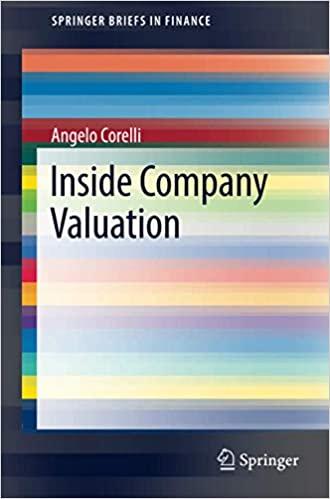investment science, please don't copy answer from other post, many thanks.

Testing CAPM using real market data Consider the following linear model: rarp= a + (rm -rf)+ where rf is the risk-free rate, rm is the return of the market portfolio, and r is the return of an asset. The residual is uncorrelated with rm. It is easy to see that CAPM corresponds to the hypothesis that a = 0. If we have a set of samples of the asset's return and of the market portfolio's return, we could run a linear regression to obtain the estimates of a and , denoted by and , respectively. If CAPM is true, should be statistically zero. Read and try the sample named Lecture Notes 5: CAPM Test in Codes and Spreadsheets folder on Blackboard (which also includes a brief introduction on where to obtain data and how to do the linear regression). Please submit the corresponding code or Excel file to support your answer. (a) Download the monthly Adjusted Close data for SPDR S&P 500 ETF Trust, Microsoft, IBM and Tesla from December 2010 to December 2020 from Yahoo Finance (121 data points each), from which you can calculate 120 monthly returns. The SPDR S&P 500 ETF Trust is considered as the market portfolio. The tickers are SPY, MSFT, IBM and TSLA. (b) Find the historical data of monthly average LIBOR rates for the same period (120 data points) and use them as the risk-free rate, and then calculate the monthly excess return of each stock. (c) For each stock you pick, run a linear regression to obtain and . Is statistically zero, at 5% significance level? (Hint: Find the p-value for the intercept coefficient in the regression) Remarks on the data: The Date column in the downloaded CSV file from Yahoo Finance and FRED refers to the month. For instance, the Adjusted Close with Date 1/12/2010 is the Adjusted Close for December 2010. So in your downloaded CSV for (a) and (b), the Date column should be from 1/12/2010 to 1/12/2020. On FRED, you can change the frequency to monthly average by using "EDIT GRAPH. Be careful that the rates are quoted as a monthly compounded annual rate in percentage. To get the monthly rate, you need to divide the downloaded value by 100 12. Testing CAPM using real market data Consider the following linear model: rarp= a + (rm -rf)+ where rf is the risk-free rate, rm is the return of the market portfolio, and r is the return of an asset. The residual is uncorrelated with rm. It is easy to see that CAPM corresponds to the hypothesis that a = 0. If we have a set of samples of the asset's return and of the market portfolio's return, we could run a linear regression to obtain the estimates of a and , denoted by and , respectively. If CAPM is true, should be statistically zero. Read and try the sample named Lecture Notes 5: CAPM Test in Codes and Spreadsheets folder on Blackboard (which also includes a brief introduction on where to obtain data and how to do the linear regression). Please submit the corresponding code or Excel file to support your answer. (a) Download the monthly Adjusted Close data for SPDR S&P 500 ETF Trust, Microsoft, IBM and Tesla from December 2010 to December 2020 from Yahoo Finance (121 data points each), from which you can calculate 120 monthly returns. The SPDR S&P 500 ETF Trust is considered as the market portfolio. The tickers are SPY, MSFT, IBM and TSLA. (b) Find the historical data of monthly average LIBOR rates for the same period (120 data points) and use them as the risk-free rate, and then calculate the monthly excess return of each stock. (c) For each stock you pick, run a linear regression to obtain and . Is statistically zero, at 5% significance level? (Hint: Find the p-value for the intercept coefficient in the regression) Remarks on the data: The Date column in the downloaded CSV file from Yahoo Finance and FRED refers to the month. For instance, the Adjusted Close with Date 1/12/2010 is the Adjusted Close for December 2010. So in your downloaded CSV for (a) and (b), the Date column should be from 1/12/2010 to 1/12/2020. On FRED, you can change the frequency to monthly average by using "EDIT GRAPH. Be careful that the rates are quoted as a monthly compounded annual rate in percentage. To get the monthly rate, you need to divide the downloaded value by 100 12








